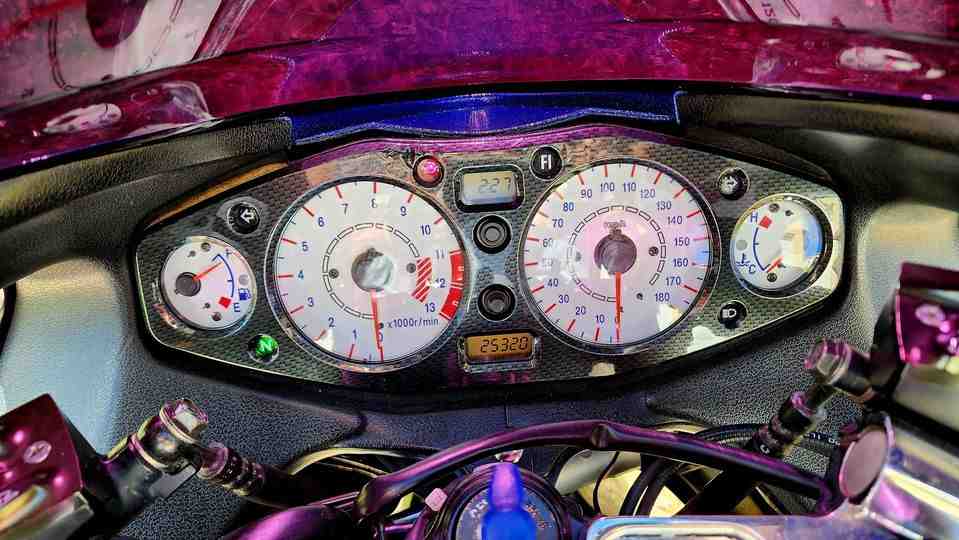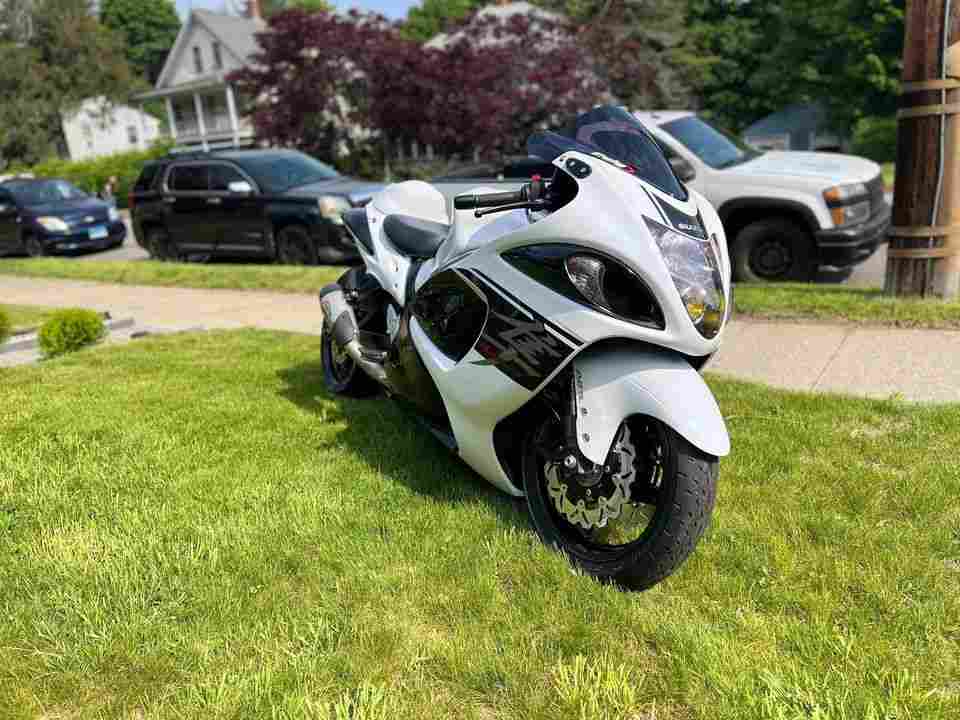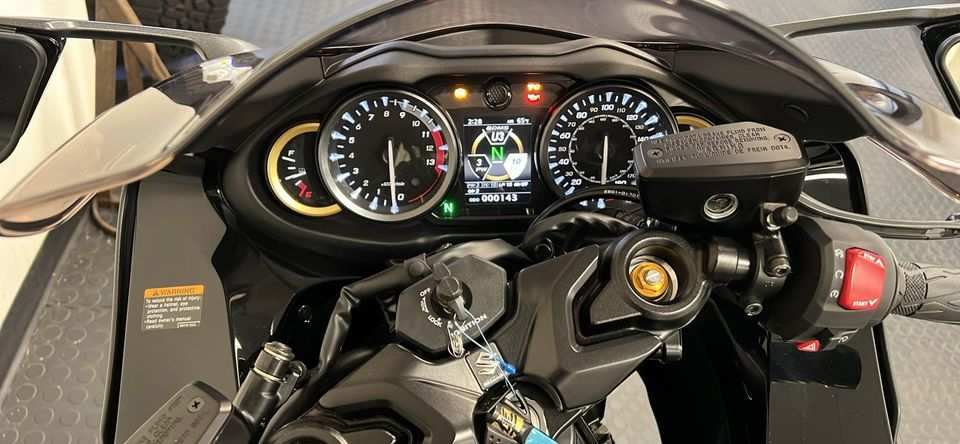The 2022 Suzuki Hayabusa’s top speed is electronically limited to 299 km/h due to safety reasons. However, modified versions, like a turbocharged Hayabusa have significantly exceeded this, breaking the 434 km/h barrier and showcasing the bike’s extraordinary performance potential beyond its factory limitations.
Suzuki Hayabusa’s Speed Limiters
Speed limiters are electronic systems integrated into vehicles, including motorcycles like the Suzuki Hayabusa, to prevent them from exceeding a certain speed. In the case of the Hayabusa, the speed limiter restricts the motorcycle’s top speed to 299 km/h. This limitation is in place due to a voluntary agreement among major motorcycle manufacturers established in the late 1990s and early 2000s.
The primary reason for using speed limiters is safety. By capping the top speed, manufacturers aim to reduce the risk of high-speed accidents, which can have more severe consequences both for the rider and for public safety on the roads.

2000 First Model Suzuki Hayabusa
Hayabusa Yearly Model Top Speeds
| Year | Model | Top Speed | Notable Changes |
|---|---|---|---|
| 1999 - 2000 | Hayabusa GSX1300R | 315 km/h | Introduction model; Fastest production motorcycle at its debut. |
| 2001 - 2007 | Hayabusa (1st Gen) | 299 km/h | Introduction of speed limiter. |
| 2008 - 2020 | Hayabusa (2nd Gen) | 299 km/h | Major redesign, Improved aerodynamics. |
| 2021 | Hayabusa (3rd Gen) | 299 km/h | Updated electronics, Refined design. |
World Records Set on Hayabusa
The Suzuki Hayabusa has not only dominated the roads with its blistering speed but also etched its name into motorcycle racing history through various top speed records.
- In 2011, Bill Warner set a monumental world land speed record on a heavily modified Hayabusa, reaching 501 km/h (311.9 mph) at the Loring Timing Association’s “Maine Event”. This record showcased the Hayabusa’s potential as the ultimate speed machine when unleashed beyond its factory limitations. – Check out the video

Bill Warner With Suzuki Hayabusa TurboCharger
- Phil Wood, riding a turbocharged Hayabusa, shattered the UK land speed record by reaching 427.8 km/h (265.8 mph) at Elvington Airfield in 2014. This achievement further cemented Hayabusa’s legacy across the globe as a symbol of speed and engineering excellence. – Video
Comparison with other Superbikes
| Motorcycle | Top Speed (Electronically Limited) | Performance Factors |
|---|---|---|
| 1. Kawasaki Ninja H2 | 322 km/h | Supercharger for increased power, advanced electronics |
| 2. BMW S1000RR | 302 km/h | Lightweight, advanced aerodynamics |
| 3. Ducati Panigale V4 R | 320 km/h | V4 engine configuration, Aerodynamic Design |
| 4. Kawasaki ZX-14R | 299 km/h | Focused on high-speed stability |
| 5. Honda CBR1000RR-R Fireblade | 299 km/h | Lightweight, balanced power delivery |
| 6. Yamaha YZF-R1 | 300 km/h | Crossplane engine for smooth power |
| 7. Kawasaki ZX-10R | 299 km/h | Advanced electronics |
Note: Most of these motorcycles are electronically limited to around 299 km/h. However, in track conditions or with aftermarket modifications (removing speed limiters), many of these superbikes can exceed their electronically limited top speeds.
Impact of Modifications For Max Speed

2022 Suzuki Hayabusa
Aftermarket modifications can significantly enhance the Busa’s top speed, pushing it beyond the electronically limited 186 mph (299 km/h). These modifications often involve several key areas:
- Engine Tuning: By reprogramming or replacing the motorcycle’s Engine Control Unit (ECU), bikers can remove the factory-imposed speed limiter, adjust fuel maps, and optimize ignition timing for better performance.
- Turbochargers: Adding a turbocharger boosts the engine’s intake air pressure, significantly increasing horsepower and torque. This is one of the most effective ways to increase the Hayabusa’s top speed and acceleration.
- Exhaust System Upgrades: Aftermarket exhaust systems can improve engine breathing, reduce backpressure, and increase power output.
- Aerodynamic Modifications: Streamlining the motorcycle’s body through custom fairings, reducing drag, and optimizing airflow can significantly improve speed by allowing the Hayabusa to cut through the air more efficiently.
- Weight Reduction: Replacing stock components with lighter aftermarket parts, such as carbon fiber body panels or lighter wheels.
Riders who have pushed the Hayabusa to its limits
Riders who have pushed the Suzuki Hayabusa to its limits describe an experience that is both exhilarating and challenging. On the track, the 2022 Hayabusa’s response is crisp and allows for quick revving up to 9000 rpm, with the traction control providing stability even at serious lean angles.

2002 Suzuki hayabusa 1st Gen Speedometer
The bike’s electronics, including wheelie control and engine braking control, are praised for their precision and effectiveness, with settings that can be tailored to the rider’s preferences. The Hayabusa’s handling is noted for its stability at speed, with a 50/50 weight distribution and a generous wheelbase contributing to its ease of maneuvering.
The updated KYB suspension is highlighted for its improvement in handling over previous generations, providing a planted and stable feel throughout the ride.
In terms of overall performance, the Hayabusa is described as a machine that has been refined and made quicker, with a focus on mid-range torque. Despite a slight reduction in peak power and torque due to emissions standards, the reworked engine internals and optimized aerodynamics result in a motorcycle that feels smoother and more responsive.
The Hayabusa’s ability to maintain speed and stability through corners, as well as its impressive acceleration, is consistently praised by riders. Overall, the Hayabusa is seen as a dominant road warrior that inspires confidence in riders, with its blend of power, handling, and advanced electronics.
Fuel Tank Capacity, Mileage and Efficiency
To balance high-speed performance with efficiency, The Suzuki Hayabusa features a fuel tank capacity of 20 liters. While mileage can vary based on riding conditions and style, it typically ranges between 16 to 18 kmpl thanks to sophisticated fuel injection systems and aerodynamic design that contribute to optimized fuel consumption.
Technical Specs Contributing to High Speed
The Suzuki Hayabusa stands as a pinnacle of high-speed engineering, captivating motorcycle enthusiasts with its raw power and aerodynamic precision. At its core, the Hayabusa is powered by a formidable 1340cc, 4-cylinder engine, designed to deliver unmatched performance.

2017 Suzuki Hayabusa 2nd Gen
Its advanced fuel injection system and high compression ratio ensure a seamless surge of power across a broad rpm spectrum, enabling breathtaking acceleration and top speeds.
Aerodynamics plays a crucial role in the Hayabusa’s ability to conquer air resistance at high speeds. Its bodywork, refined through wind tunnel testing, is not just visually striking but functionally adept at slicing through the air. The design minimizes drag while enhancing stability and control, allowing the Hayabusa to cut through the air with ease.
Conclusion
The Hayabusa, also known as the Busa, was initially created to compete with Honda’s Blackbird and has since gone head-to-head with Kawasaki’s ZZ-R1200s and the ZZR1400 series.
Nowadays, there are other bikes like the Kawasaki H2 that can outperform the Busa in straight-line speed, along with some powerful Italian V4s. But when it comes to the sheer experience of riding, the Hayabusa has its charm with its powerful engine and stability.
In the realm of highest cc bikes, where engine size often equates to bragging rights, the Busa will always be remembered as a legendary bike.








